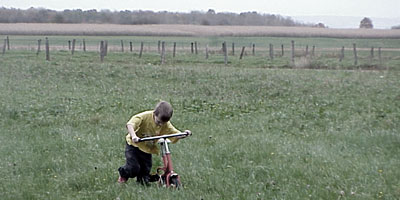Planning Policy Guidance 13: Transport
Our quality of life depends on transport and easy access to jobs, shopping, leisure facilities and services; we need a safe, efficient and integrated transport system to support a strong and prosperous economy. But the way we travel and the continued growth in road traffic is damaging our towns, harming our countryside and contributing to global warming.
Land use planning has a key role in delivering the Governments integrated transport strategy. By shaping the pattern of development and influencing the location, scale, density, design and mix of land uses, planning can help to reduce the need to travel, reduce the length of journeys and make it safer and easier for people to access jobs, shopping, leisure facilities and services by public transport, walking, and cycling.

Consistent application of these planning policies will help to reduce some of the need for car journeys (by reducing the physical separation of key land uses) and enable people to make sustainable transport choices.
These policies are therefore part of the Governments overall approach to addressing the needs of motorists, other road and public transport users, and business by reducing congestion and pollution and achieving better access to development and facilities. They will also help to promote sustainable distribution. In this way, planning policies can increase the effectiveness of other transport policies and help maximise the contribution of transport to improving our quality of life.
In order to deliver the objectives of this guidance, when preparing development plans and considering planning applications, local authorities should:
- 1. actively manage the pattern of urban growth to make the fullest use of public transport, and focus major generators of travel demand in city, town and district centres and near to major public transport interchanges;
- 2. locate day to day facilities which need to be near their clients in local centres so that they are accessible by walking and cycling;
- 3. accommodate housing principally within existing urban areas, planning for increased intensity of development for both housing and other uses at locations which are highly accessible by public transport, walking and cycling;
- 4. ensure that development comprising jobs, shopping, leisure and services offers a realistic choice of access by public transport, walking, and cycling, recognising that this may be less achievable in some rural areas;
- 5. in rural areas, locate most development for housing, jobs, shopping, leisure and services in local service centres which are designated in the development plan to act as focal points for housing, transport and other services, and encourage better transport provision in the countryside;
- 6. ensure that strategies in the development and local transport plan complement each other and that consideration of development plan allocations and local transport investment and priorities are closely linked;
- 7. use parking policies, alongside other planning and transport measures, to promote sustainable transport choices and reduce reliance on the car for work and other journeys;
- 8. give priority to people over ease of traffic movement and plan to provide more road space to pedestrians, cyclists and public transport in town centres, local neighbourhoods and other areas with a mixture of land uses;
- 9. ensure that the needs of disabled people as pedestrians, public transport users and motorists - are taken into account in the implementation of planning policies and traffic management schemes, and in the design of individual developments; consider how best to reduce crime and the fear of crime, and seek by the design and layout of developments and areas, to secure community safety and road safety; and
- 10. protect sites and routes which could be critical in developing infrastructure to widen transport choices for both passenger and freight movements.
« Previous Article - Next Article »
Nov 2004
